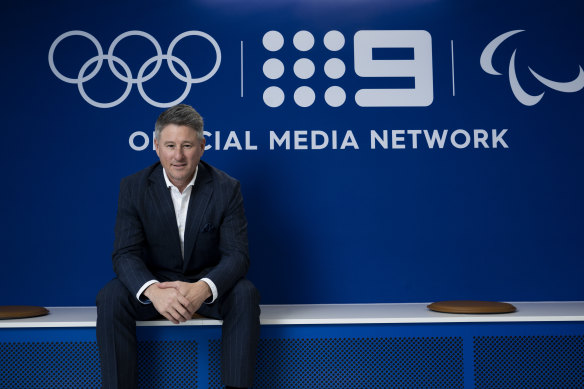This was published 11 months ago
Job cuts prompt anger and threat of industrial action at Nine
By Calum Jaspan
Union staff across Nine Entertainment’s publishing business have voted to apply for protected industrial action, and passed a unanimous vote of no confidence in chief executive Mike Sneesby and the board, after the company announced up to 200 jobs would be made redundant across the business.
Members of the Media Entertainment & Arts Alliance, who account for most editorial staff at The Age, The Sydney Morning Herald, The Australian Financial Review, The Brisbane Times and WA Today, met soon after an email from publishing boss Tory Maguire said up to 90 jobs were expected to be lost from the division alone.

Nine chief executive Mike Sneesby.Credit: Janie Barrett
A union vote to demand she address the staff immediately was passed unanimously. Maguire had previously outlined intentions to address staff on Monday.
In a note distributed by the union, staff express their “fury” over the redundancies.
“We express our dismay that senior editors appear to have been kept in the dark until the last moment about the planned job cuts, despite the end of Meta funding being known for months,” the note said.
Staff and management are engaged in negotiations over a new enterprise bargaining agreement and the application for industrial action relates to that. But the announcement of job cuts prompted the union to push forward with the move.
In an email on Friday, Sneesby told staff the cuts were prompted by a weak advertising market and the likely end of a commercial deal with Meta, the owner of Facebook and Instagram.
Nine Publishing is heavily affected by the loss of about $15 million in annual Meta revenue after the digital platform walked away from the news media bargaining code. The publishing division contributed 28 per cent of Nine’s earnings, despite contributing just 21 per cent of revenue in fiscal 2023.
Meanwhile, 38 jobs will be cut from Nine’s news and current affairs broadcast team. The cuts come after a year of further job losses across the company.
Sneesby said that Nine, despite being well-placed to manage the cyclical challenges facing media companies, was not immune to the “economic headwinds impacting many businesses globally”.
“In order for us to be able to keep investing in digital growth opportunities across Nine, we must continue to responsibly manage costs through the cycle,” he said.
“From our nationwide team of almost 5000 people, around 200 jobs are expected to be affected across Nine including some vacant and casual roles not being filled.”
The cuts are part of a bid to find more than $30 million in savings across the business.
Nine’s share price rose 1.8 per cent on Friday after the announcement. Since the beginning of the year, shares are down 30 per cent.

Nine’s director of publishing, Tory Maguire.Credit: Louie Douvis
Commercial rivals Seven West Media and News Corp also announced a series of cuts recently. Each company has received about $15 million from Meta across the past three years. Those deals expire on Sunday.
Seven is set to make 150 staff redundant as it deals with one of the softest advertising markets in several decades. News Corp has made as many as 80 staff redundant across its sales division. Some senior executives and editors have also departed. The company is expected to make more cuts across its editorial division.
As of September 2023, Nine employed 4753 people in all divisions. It is also the owner of this masthead. A cut of up to 200 roles equates to about 4 per cent of Nine’s workforce.
Nine’s publishing boss, Tory Maguire, said she would work with her team and editors on a plan to reduce staff costs in coming weeks, resulting in the first headcount reduction across the newspapers since 2017, when they were owned by Fairfax Media.
“We will be focused on finding efficiencies where we can, and making prudent decisions so we can continue to invest in growth areas that are driving subscriptions. We are looking at reducing the publishing division headcount by between 70 and 90 staff over coming months,” Maguire said.
Acting media director for the union Michelle Rae said it acknowledged the impact from Meta’s decision, but that it urged Nine and other media companies to find savings elsewhere.
“Any cuts to editorial will mean reduced coverage of a range of matters and result in a less informed Australian public,” Rae said.
Sneesby said these were “tough decisions” and he acknowledged it would be an uncertain period for some staff.
Revenue streams in the business have drastically changed since Nine’s merger with Fairfax Media in 2019, bringing broadcast television, newspaper publishing, radio, digital and streaming video on demand (Stan) platforms together.
Nine’s broadcast division, which includes television and radio, has declined in influence as advertisers diversify their spend and move away from free-to-air mediums. In Nine’s first financial results after the merger, broadcast was responsible for about 66 per cent of revenue. In its most recent half-year results for the 2024 financial year, broadcast had fallen to 47.7 per cent of revenue. Stan made up 8.5 per cent of revenue in 2019.
Last Friday, Sneesby hinted at cuts while speaking at a parliamentary inquiry into social media companies in Australia. He laid blame at the feet of Meta, which has so far refused to negotiate a second commercial deal with publishers under the news media bargaining code.
He said 50 journalists had been hired as a result of the bargaining code money.
The announcement adds to a turbulent two months for Nine, which has been rocked by reports of its handling of the departure of former Nine news and current affairs director Darren Wick.
The company’s chair, Peter Costello, then stood down under mounting pressure after he appeared to knock over a reporter from The Australian in Canberra Airport. Deputy chair Catherine West was appointed as his successor.
The Business Briefing newsletter delivers major stories, exclusive coverage and expert opinion. Sign up to get it every weekday morning.